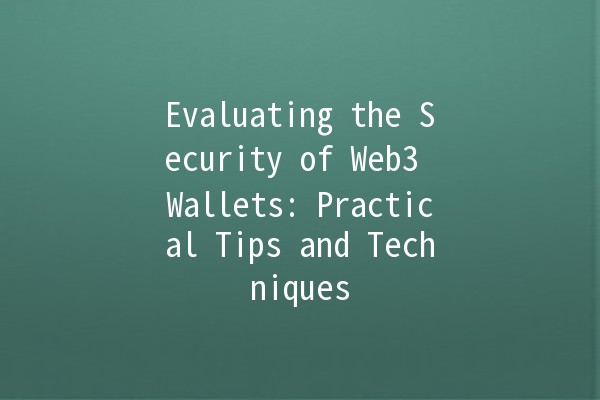
In recent years, Web3 wallets have gained immense popularity, and for good reason. As a cornerstone of the decentralized web, these wallets allow users to manage and interact with various cryptocurrencies and decentralized applications seamlessly. However, security remains a major concern—Inevitably, vulnerabilities can lead to significant financial loss and a breach of privacy. How then can individuals ensure the security of their Web3 wallets? This article delves into essential tips and techniques that you can incorporate to safeguard your digital assets effectively.
Understanding Web3 Wallets
Before diving into the security measures, it's crucial to understand what Web3 wallets are and how they operate. Web3 represents the third generation of the internet, focusing on decentralization, blockchain technologies, and user ownership. Web3 wallets enable users to store their cryptocurrencies, tokens, and NFTs, as well as access decentralized applications (dApps).

There are primarily two types of Web3 wallets:
Software Wallets: Desktops or mobile apps that allow users to store their assets securely. While convenient, they are more vulnerable to malware attacks.
Hardware Wallets: Physical devices that store cryptocurrencies offline. These provide a higher level of security since they are not connected to the internet.
By understanding your wallet's functionality, you can take the necessary steps to reinforce its security.
Five Key Security Strategies for Web3 Wallets
Enabling 2FA adds an additional layer of security to your wallet. This means that even if someone tries to gain access to your account, they will need a second form of verification, usually sent to your mobile device.
Implementation Example: Most wallet providers support 2FA through applications like Google Authenticator or SMS verification. When setting up your wallet, ensure that you enable this option and keep your mobile device secured.
Creating a strong password is fundamental for protecting your wallet. Weak passwords can be easily guessed or cracked by hackers.
Implementation Example: Use a password manager to generate and store complex passwords. Ensure that each password is unique and not reused across different platforms. A strong password typically consists of a mix of letters, numbers, and special characters.
Outdated software can expose your wallet to vulnerabilities that hackers can exploit. Always keep your wallet application, operating system, and antivirus solutions updated.
Implementation Example: Enable automatic updates on your wallet and devices. Regularly check for updates and install them promptly to ensure that you have the latest security patches.
Phishing attacks are common in the crypto community. These take the form of emails or messages that trick users into revealing their wallet credentials through fake websites.
Implementation Example: Always verify the URLs of websites from which you access your wallet. Ensure they are legitimate and secure (look for HTTPS). Avoid clicking on suspicious links, and consider accessing your wallet through bookmarks rather than typing URLs.
Regular backups are essential for data recovery in case your device fails or you lose access to your wallet. Failing to back up your wallet can lead to permanent loss of your assets.
Implementation Example: Most wallets offer a recovery phrase during the setup process. Write this down and store it in a secure location. Additionally, some wallets allow you to export private keys, which should also be safely stored.
Common Security Questions About Web3 Wallets
If you suspect your wallet has been compromised, immediately transfer your assets to a new wallet. Change your passwords and enable 2FA if you haven’t already. Review recent transactions to identify any unauthorized activities.
If you forget your password but have your recovery phrase, you will usually be able to recover your wallet. Most wallets will ask for the recovery phrase during the recovery process. Without the recovery phrase, access may be permanently lost.
Yes, hardware wallets generally offer more security than software wallets because they store your private keys offline. However, they still require proper usage and care to maintain their security.
Research the wallet provider by checking online reviews, their community engagement, and any past security incidents. A reputable provider should have a transparent history and strong user support.
Using multiple wallets can enhance security by diversifying risk. For instance, you might keep your most valuable assets in a hardware wallet while using a software wallet for everyday transactions.
When transferring assets, doublecheck the receiving address, and consider making small test transfers before sending larger amounts. Use secure networks to execute transactions, and avoid public WiFi when dealing with sensitive financial transactions.
Security Beyond the Basics
While the above tips form the foundation of wallet security, advanced users may also consider additional strategies:
MultiSignature Wallets: These require multiple private keys to authorize a transaction, providing extra security by requiring consensus among several parties.
Cold Storage Solutions: Consider using cold storage methods where your assets are kept offline, making them impervious to online threats.
Be Mindful of DApp Permissions: When using dApps, be cautious about granting permissions to access your wallet. Review the permissions you’re providing and revoke access from apps you no longer use.
Educate Yourself: Continuously educate yourself about the latest security trends in cryptocurrency. The digital landscape is everevolving, and staying informed can help you respond to new threats effectively.
Securing a Web3 wallet is paramount for anyone looking to engage with cryptocurrencies and decentralized applications. By implementing the strategies discussed and remaining vigilant against potential threats, you can better safeguard your digital wealth.
Remember, security is not a onetime effort but an ongoing practice. As you navigate your Web3 journey, prioritize security to ensure that your transactions and assets remain safe and sound. 🌐💪

